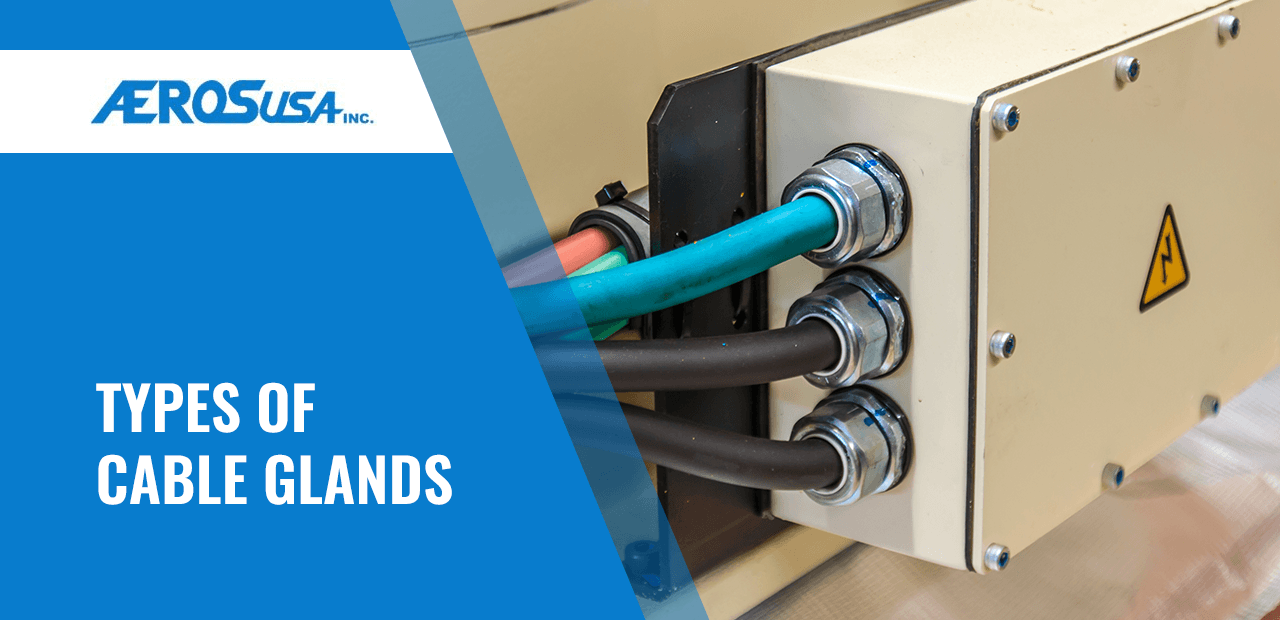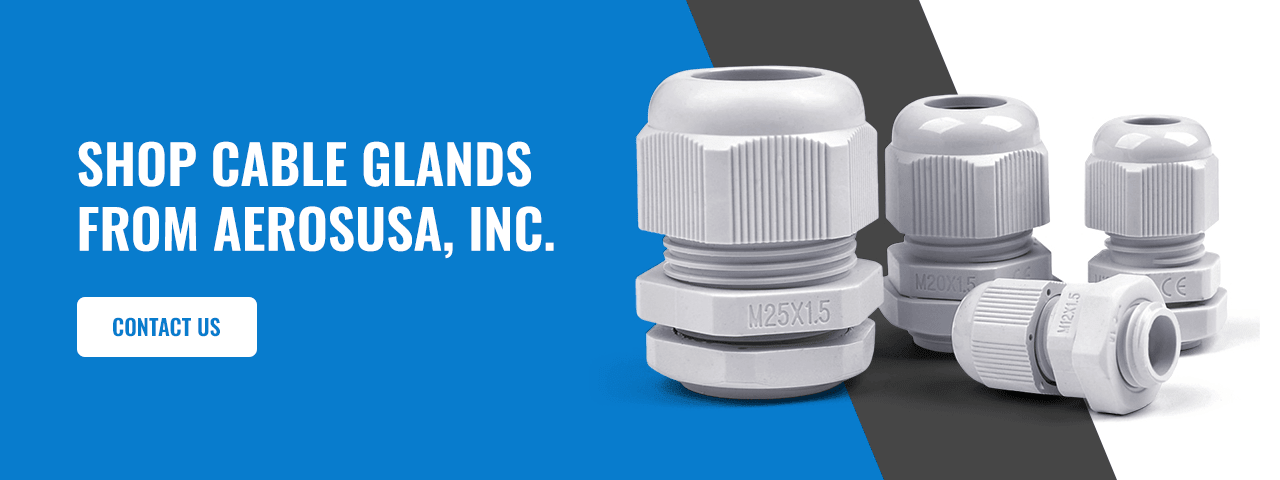
Cable glands are small but vital tools to use when connecting cables to electrical equipment. There are various cable gland types that feature distinct materials and designs or cater to specific applications. AerosUSA is a leading cable gland manufacturer and supplier serving businesses across industries. Work with us to purchase cable glands that meet your situation’s demand.

Table of Contents
Cable Glands Explained
A cable gland is a small device that connects an electrical cable to a piece of equipment such as an automation system, electrical system, instrumentation tool or control device. Cable glands come in different sizes to support cables ranging from 1-75 millimeters in diameter. They comprise five parts — a sealing nut, locknut, washer, body and seal. The assembly clasps onto the cable and screws onto the electrical equipment’s threads.
Cable glands fulfill three important roles:
- Securing the cable: Cable glands ensure a firm connection between the cable and equipment.
- Relieving cable strain: Cable glands attach at an angle that helps the cable resist pulling forces that would damage the wires.
- Sealing the cable: Cable glands seal the wire and equipment from dust, debris and moisture.
Cable Gland Materials
A cable gland’s performance starts with its material. Manufacturers design cable glands using various metallic and non-metallic materials.
Metal
Metal cable glands feature materials like stainless steel, nickel-plated brass or aluminum. These materials are the most stable and durable options to use when a strong connection is essential. Metal cable glands also offer thermal conductivity and resist corrosion. The advantages that metal cable glands offer make them the ideal choice when connecting medical and chemical equipment, information technology devices and power equipment.
Plastic
Plastic cable glands are stable and versatile, offering a cost-effective solution in applications that do not involve extreme conditions. Most plastic cable glands feature materials like polyamide or nylon, which resist corrosion in most environments. Choose a plastic cable gland when connecting wires to equipment in telecommunications and marine applications, as well as equipment that uses flex cables.
Armor Compatability
Beyond their materials, cable glands also fall into categories according to the types of cables with which they are compatible. Cable glands feature distinct designs for armored and unarmored cables.
Armored Cables
Armored cables feature a protective layer between the interior wires and exterior sheathing. The armor is woven from a durable material like metal, fiber yard or polyethylene. Covering the interior components ensures durability in applications that test the cable’s mechanical strength. An armored cable is slightly larger than a standard cable and therefore requires size accommodations from the cable gland. It also features a clamping or locking mechanism that terminates the cable’s mechanical and electrical components and connects to the armor.
Unarmored Cables
Unarmored cables are standard variations used in many common applications. They lack the additional protective measures that armored cables feature, so they cost less and are ideal for low-risk applications. However, they still include outer seals that prevent ingress and retain the cable’s strength. Unarmored cables are available in all standard sizes and are compatible with standard cable glands.
Cable Glands for Specific Applications
There are also a few cable gland categories that describe the specific applications they fit. The four primary application-specific types of cable glands include:
- Electromagnetic compatibility (EMC) glands
- Marine cable glands
- Electric cable glands
- Fire-stop cable glands
Electromagnetic Compatability Cable Glands
An EMC gland protects the cable and machine from electromagnetic interference (EMI) that compromises electrical equipment’s functionality. Using an EMC gland creates a barrier against EMI at the termination point. EMC glands are common in telecommunications applications and other situations where EMI can disrupt a machine.
Marine Cable Glands
The marine industry often requires waterproof cable glands for equipment used underwater or in damp environments. A marine cable gland forms a watertight seal at the termination point where the cable connects to an enclosure. The gland features components that connect on both sides of the enclosure during assembly. Waterproof cables are also common at wastewater treatment facilities.
Electric Cable Glands
Electrical cable glands are metal devices featuring an earthing clamp or tag. The earthing component prevents electrocution by redirecting the electrical current to the ground through the wire. It also protects the connection in the event of a short.
Fire-Stop Cable Glands
A fire-stop cable gland resists fires and explosions. Using a fire-stop gland reduces the spread of fire and smoke. The glands also keep the electrical connection intact so that the machine can continue operation if necessary. Fire-stop glands are common in the rail industry to protect the passengers, personnel and goods onboard a train. The gland will prevent the spread of fire and smoke while allowing the train to continue functioning until it can reach a safe area.
Cable Gland Designations
You will often see cable glands given specific designations according to BS 6121. This British Standard was originally a standardization method for cable strain reliefs in the industrial sector and specified requirements for different designs. Although this is no longer the most current standard in the EU, it still serves as a valuable designation among manufacturers to communicate types of glands and their key features. Some of the most common types and designations include:
1. Type A Cable Glands
Type A glands may also be referred to as “stuffing glands” and are commonly used on unarmored plastic or rubber-sheathed cables. There are four A-type designations:
- Type A1: Type A1 cable connectors are often plastic glands used to protect the cable’s outer jacket.
- Type A2: Type A2 cable glands may be plastic or brass and feature an IP68-designated seal between the cable’s outer jacket and the gland.
- Type A3: The type A3 cable strain relief is a variation of the type A1 gland. This grip variety includes an electrical bond for the inner jacket of the cable.
- Type A4: The type A4 cable gland is a variation of the type A2 gland. This connector also features an electrical bond for the inner jacket of the cable.
A-type glands are often used in indoor and outdoor applications where armored cables are unnecessary.
2. Type B Cable Glands
Type B cable glands are designed for use on single-wire armored cables made with plastic or rubber sheaths. The glands themselves are made of brass and are designed for securing the cable’s armor and providing an electrical path between the armor and the gland. These cord grip designs are made for use in indoor applications where moisture exposure is low.
3. Type C Cable Glands
Type C cable glands are designed for use on plastic or rubber sheathed cables with armor or braiding. Type C cables are made of brass or stainless steel and serve a similar purpose as the type B cable gland.
The primary difference between the two designations is that the type C cord grip features an IP68-designated seal between the outer sheath and the gland. This seal provides an extra level of protection against moisture and environmental exposure, making this connector design suitable for outdoor applications with a greater need for weatherproofing and waterproofing.
4. Type D Cable Glands
Like B-type cables, type D cables are designed for use on armored or wire braided lines with plastic or rubber outer sheaths. The key difference between this cable gland variation and the type B cable gland is that it features an IP68-designated seal between the inner sheath and the threaded fixing part.
There are two variations of the type D cable gland:
- Type D1: This cable gland is the basic version of the type D design, featuring the IP68 seal between the inner sheath and the fixing component.
- Type D2: This variation has the same seal as the D1 variation and features an electrical bond for the inner sheath of the cable.
5. Type E Cable Glands
Type E cable glands are used on cables with armor or braiding and plastic or rubber outer sheaths. The type E cord grip is often made of brass or stainless steel. It’s similar to the C-type cable connector design, with an armor locking ring and inner and outer seals rated to IP68. The outer seal grips the cable sheath, while the inner seal grips the cable’s bedding layer.
There are two variations of the type E cable gland:
- Type E1: The type E1 cable gland has all the basic features of the E variation.
- Type E2: The E2 variation has all the characteristics of the E1 cord grip design and includes an electrical bond for the inner sheath of the cable.
Type E cable glands are highly suitable for applications with exposure to the elements as the seal features of E variation offer excellent waterproofing and weatherproofing.
6. BS 6121 Suffixes
In addition to the variations above, cord grips with B, C, D, and E designations will also often feature a suffix along with the classification. This suffix indicates the specific armoring the gland is designed for. These suffixes are defined as follows:
- W for single wire armored cables
- T for pliable wire armored cables
- X for wire braided cables
- Y for aluminum strip armored cables
- Z for double steel tape armored cables
In practice, the cable gland will be designated with their cable type first and their protection suitability immediately after. For example, a type C cord grip designed for a single wire armored cable will have a designation of “CW.” If a gland design may be used for more than one armoring variation, all the relevant suffixes will be added after the cable gland type. For example, a type B cable connector designed for both single and pliable wire armored cables will have a designation of “BWT.”
How to Choose a Cable Gland
With so many different cable connector features and designs to sift through, it can be challenging to determine which type of cable gland to use for a specific application and what features to look for. The key to making this choice is to identify the application’s needs first and then eliminate cable fitting options using this information. Some key questions to ask when selecting a cord grip include:
- What is the nature of installation — domestic, commercial or industrial?
- Will the cable gland be in an indoor or outdoor environment?
- What are the temperature conditions for the environment, and how much will they fluctuate?
- Will the cable gland be exposed to moisture, dust, dirt or corrosive elements?
- Will there be any risk factors in the environment, such as an explosive or corrosive atmosphere?
- What is the cable size, and does it feature any armoring? If it does have armor, what type?
Once you have narrowed down your cable gland options to suit your application’s needs, you can then make a final decision based on cost.
Shop Cable Glands From AerosUSA, Inc.
Cable glands are a small yet essential piece of equipment in nearly every industry. Whether you’re working in the aerospace, marine, power, telecom or industrial sectors, cable glands are a key safety feature. The importance of cable fittings can’t be understated, so it’s essential to find quality designs that fit perfectly into your application and environment. AerosUSA can help.
AerosUSA is a leading supplier of wire and cable protection systems. Our products, manufactured by Flexa GmbH, include everything from cable covers and shielding systems to high-quality cable glands. Our experience spans a range of industries, and we carry a selection of products that is just as diverse. On top of it all, we offer quick responses, competitive pricing and fast turnaround times.
Contact AerosUSA today to learn more about cable glands and our selection.


